Mad Hedge Biotech and Healthcare Letter
November 16, 2021
Fiat Lux
Featured Trade:
(FORGOTTEN COVID-19 STOCK STILL ALIVE AND KICKING)
(GILD), (REGN), (MRNA), (AZN), (JNJ), (PFE), (BNTX), (MRK)
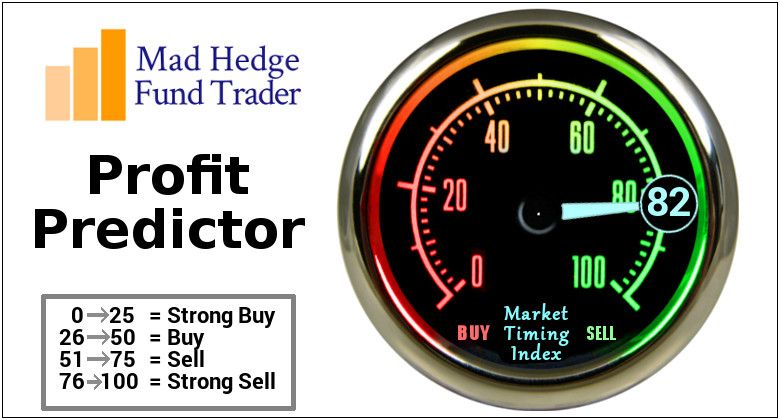
Mad Hedge Biotech and Healthcare Letter
November 16, 2021
Fiat Lux
Featured Trade:
(FORGOTTEN COVID-19 STOCK STILL ALIVE AND KICKING)
(GILD), (REGN), (MRNA), (AZN), (JNJ), (PFE), (BNTX), (MRK)

At times, it can be rewarding to go against the tide. This can also be applicable to the stock market.
Forgotten names or companies with shares that got hammered can eventually transform into remarkable investment opportunities. After all, it's always wise to invest in a quality stock when it loses some serious altitude.
Now, let's take a look at a biotechnology and healthcare business that has been performing poorly in the past 12 months but still holds a promising chance of bouncing back: Gilead Sciences (GILD).
This biotechnology giant is still reeling after its recent regulatory setback involving Filgotinib, a potential treatment for rheumatoid arthritis.
Initially, Filgotinib was slated as Gilead Sciences' next blockbuster drug. Unfortunately, the US FDA didn't agree with those plans.
The regulatory body rejected the treatment, pointing out the risks of patients developing male fertility problems as one of the significant reasons.
By November 2020, Gilead Sciences completely abandoned the Filgotinib project, at least in the United States.
Prior to this, Gilead Sciences took center stage when its Remdesivir, sold under the brand name Veklury, was identified as an effective COVID-19 treatment.
While this product has taken the back seat since other treatments from the likes of Regeneron (REGN) and especially vaccines from Moderna (MRNA), Johnson & Johnson (JNJ), AstraZeneca (AZN), Pfizer (PFE), and BioNTech (BNTX) have emerged, it still generated impressive numbers.
In the second quarter alone, Veklury brought in $829 million in revenue.
Gilead Sciences anticipate sales to reach somewhere between $2.7 billion and $3.1 billion for this drug in 2021.
Arguably, though, the biggest draw in buying Gilead Sciences stock is its HIV pipeline.
To date, the company holds roughly 75% of the market share in the US and approximately 50% in Europe.
What's even more promising is that the company's top-selling HIV product, Biktarvy, still has vast room to grow.
This is impressive considering that Biktarvy raked in approximately $2 billion in sales in the second quarter of 2021, showing off a 24.3% year-over-year jump.
Looking at its trajectory and considering that the drug generated $7.3 billion in 2020, Biktarvy sales are estimated to hit $11.7 billion in 2026.
More than the company's incredible dominance in cornering the HIV market, Gilead Sciences also has an excellent pipeline with over three dozen clinical programs queued.
Inevitably, one of its major concentrations is expanding its HIV portfolio.
In fact, it has recently teamed up with fellow biotechnology giant Merck (MRK) to collaborate on a potential HIV treatment—a candidate that's anticipated to equal if not surpass Biktarvy's fame.
One more potential blockbuster in the HIV market is Lenacapavir, which is an injection regiment that Gilead Sciences recently submitted for approval to the FDA.
If granted the green light, this will be administered once every 6 months, making it the first-ever long-acting regimen for HIV patients.
Meanwhile, the company is also growing its Hepatitis B franchise to avoid being too dependent on a single market.
So far, Gilead Sciences estimates about $1 billion in sales for this lineup in 2022, making the Hepatitis B portfolio a reliable part of the business.
Another growing section of the business is its cell therapy segment, with Yescarta and Tecartus nearing their peak performances at $1 billion in sales yearly.
Even its newly developed cancer cell therapy Magrolimab looks promising, with the potential to rake in another $1 billion in peak sales as well.
Needless to say, Gilead Sciences' new products and expansions have been displaying realistic potential to drive billions in added yearly revenue.
Overall, Gilead Sciences is a stable and profitable biotechnology and healthcare business.
It's a large-cap biopharmaceutical organization and market leader that has been solidly performing well for over 3 decades, with an influential presence in more than 35 countries.
Despite its recent challenges, Gilead Sciences remains an excellent buy, especially on the dip.
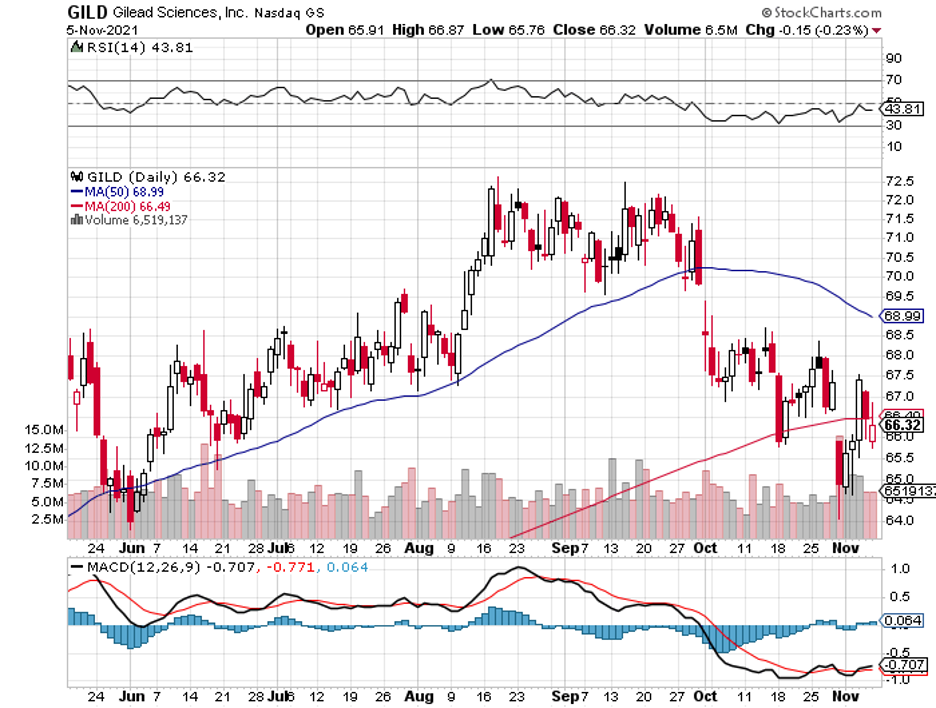
Mad Hedge Bitcoin Letter
October 7, 2021
Fiat Lux
Featured Trade:
(A RARE BLUE-CHIP STOCK IN DEEP VALUE TERRITORY)
(MRK), (NVAX), (MRNA), (BMY), (XLRN)
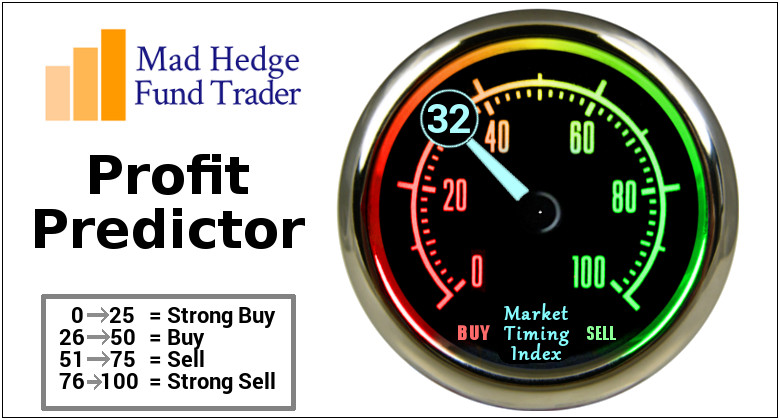
Merck (MRK) is facing a huge problem. In roughly seven years, its top-selling megablockbuster cancer treatment Keytruda is set to lose its patent exclusivity.
This is a major concern for the company, considering that Keytruda comprised over a third of the their revenue in 2020.
This impending “doom” appears to have scared off investors, as Merck stock has been trading at at least 12 times the earnings expected within the next 12 months.
However, it looks like Merck is slowly gearing up to reveal the solutions it came up with to address this major problem.
The first sign of a turnaround is Merck’s recent news about releasing an oral antiviral pill for COVID-19.
Immediately after the release of the positive data, the biopharmaceutical giant’s $206 billion market capitalization climbed by $16 billion, showing off an 8.4% in its share price.
In comparison, other COVID-19 vaccine stocks experienced significant selloffs. Novavax (NVAX) fell by 12%, while Moderna (MRNA) slipped by 11%.
Merck’s COVID-19 pill, called Molnupiravir, is expected to be a cheaper, safer, and more effective alternative to the current antiviral treatment available today, which is Remdesivir from Gilead Sciences (GILD).
Molnupiravir has been so promising that the US government already sealed a $1.2 billion contract with Merck to get 1.7 million doses of the drug months before the announcement.
While there’s still no final word on the pricing, the US government’s deal places the drug at $700 per dose.
Given its manufacturing capacity, Merck disclosed that it could easily produce six times that order, with the company targeting roughly 10 million courses by the end of 2021.
Using these numbers, it’s easy to see how Merck can generate $7 billion in sales of Molnupiravir alone this fourth quarter.
Although Molnupiravir’s sales won’t be a game-changer for Merck in the same way Moderna’s COVID-19 vaccine candidate changed its landscape, the $7 billion revenue would still offer a significant boost.
Another 10 million doses of Molnupiravir are slated for release by 2022, indicating higher sales for Merck in the coming months.
Aside from working as an antiviral pill, Molnupiravir is also believed to be effective against other known viruses like influenza.
Considering the surging demand for travel these days, there’s a huge possibility that Merck’s oral drug will be handed out like candy canes as a potential preventive measure.
After all, the efficacy of the COVID-19 vaccines, especially for those who got jabbed earlier than most, would start to wane at this point.
Taking into account the demand for this pill worldwide, it’s realistic to assume that Molnupiravir can generate $35 billion to $70 billion in revenue for Merck.
Even before the news about Molnupiravir broke, Merck already raised its revenue guidance for 2021 to somewhere between $46.4 billion to $47.4 billion, signaling 12% to 14% growth.
Aside from its COVID-19 drug, Merck has been busy expanding its portfolio that already covers oncology, hepatitis, and HPV.
One of its latest moves to achieve this goal is its $10.8 billion acquisition of Acceleron Pharma (XLRN)—a deal Merck snagged right under the nose of the strongest contender in the race, Bristol-Myers Squibb (BMY).
Merck’s acquisition of Acceleron will boost the cardiovascular pipeline of the company, including treatments for life-threatening blood vessel conditions.
These are on top of its growing vaccine business, which still has four queued for Phase 2 clinical trials and another for regulatory review.
These candidates effectively make Merck a critical player in the rapidly expanding vaccine market—a segment that’s projected to rise from $42 billion in 2020 to $74 billion by 2028.
Overall, Merck is one of the unparalleled blue-chip stocks trading in deep-value territory these days.
It’s hitting all cylinders, showing off a stable expansion of its key franchises and an impressive balance sheet to fund its R&D plans.
Merck has become the poster child of a remarkable stock valued at a reasonable price.

Mad Hedge Biotech & Healthcare Letter
October 5, 2021
Fiat Lux
FEATURED TRADE:
(A BIOTECH STOCK THAT LETS YOU SLEEP THROUGH THE NIGHT)
(AMGN), (AZN), (GSK), (REGN), (SNY), (MRK)
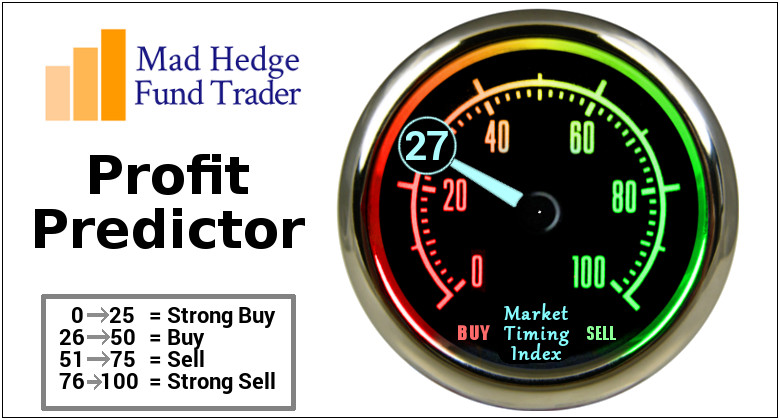
Great investors have learned that the critical element when it comes to long-term investing is concentrating on stocks that hold a profound presence in their fields and that will continue to grow in the decades to come.
In terms of trends, the best thing to do is to determine something that will affect the world by generating millions—if not billions—of steady customers.
Among the stocks in the biotech industry today, one stands out to benefit from solid future demand for its products: Amgen (AMGN).
Amgen is one of the biggest biopharmaceutical companies across the globe, holding an equity market capitalization of roughly $127 billion. Despite its size, it simply can’t quite catch a break, with its share price continuing to slide in the past week.
While short-term investors may see this as a weakness, it’s moments like these that distinguish genuine value investors from the rest.
Let’s take a look at a company that has been thrown in the bargain bin for no apparent reason, and understand why this could be our opportunity.
A recent promising addition to Amgen’s pipeline is its experimental asthma drug, Tezepelumab, which it’s co-developing with AstraZeneca (AZN).
There are approximately 2.5 million patients worldwide who suffer from severe, uncontrolled asthma, accounting for almost 50% of all asthma-related expenses in the healthcare system.
This is because the majority of the 439,000 asthma-related hospitalizations, as well as 1.3 million emergency room visits annually in the US alone, are caused by severe, uncontrolled asthma.
Moreover, it was found that 1 in 5 severe asthma patients tend to develop a benign growth called nasal polyps in the sinuses of their noses. These can end up blocking their nasal passages, worsening their breathing problems, and diminishing their sense of smell.
This is the very market that Amgen’s Tezepelumab targets to help.
Tezepelumab is the first and only treatment that focuses on the symptoms of severe, uncontrolled asthma patients.
Considering the positive results of its late-stage trials, Amgen and AstraZeneca are confident that Tezepelumab will receive regulatory approval from the US FDA by the first quarter of 2022.
When that happens, this will mark Amgen’s first-ever foray into the asthma treatment sector—and it’s entering the market with a potential blockbuster to boot.
The global asthma market is projected to grow from $20.6 billion in 2020 to $37.3 billion in revenue by 2030.
So far, the other names aiming to dominate this segment include GlaxoSmithKline (GSK), Regeneron (REGN), and Sanofi (SNY).
Considering the competition, a modest estimate is to expect Tezepelumab to seize at least 5% of the market share following its approval.
That would work out to roughly $1.9 billion in yearly revenue, divided between AstraZeneca and Amgen.
Taking into account that Amgen is forecasting its 2021 revenue to be within the range of $25.8 billion and $26.6 billion, the addition of $1 billion annually would surely move the needle.
Moreover, the cherry on top is that Tezepelumab is a clear indicator of the company’s efforts to diversify its revenue base and enter a market that it has yet to establish its presence.
Apart from Tezepelumab, Amgen has also been working on expanding its blockbuster lung cancer drug Lumakras, which generated $2.5 billion in annual sales.
To date, Lumakras is expected to emerge as a solid contender to unseat Merck’s (MRK) Keytruda in the lung cancer segment.
In addition, the company is studying how to utilize Lumakras as a potential treatment for colorectal cancer.
Amgen has also been expanding its pipeline of biosimilar candidates.
The most exciting candidates include its biologic version of Johnson & Johnson’s (JNJ) psoriatic arthritis and psoriasis medication Stelara, Regeneron’s chronic eye disease drug Eylea, and AstraZeneca’s rare disease treatment Soliris.
Even AbbVie’s (ABBV) impending loss of exclusivity for its top-selling rheumatoid arthritis drug Humira is under the company’s radar, with Amgen already prepared to launch its own biosimilar domestically in the form of Amjevita by 2023.
Getting the regulatory green light for these treatments would allow Amgen to poach on hundreds of millions, if not billions, in annual revenue from its competitors.
Apart from its pipeline candidates and strong performance in niche segments, Amgen has demonstrated a solid track record when it comes to capital returns via share buybacks.
In the second quarter of 2021 alone, the company has splurged on 6.5 million in shares repurchases. Amgen expects to reach a total of $3 billion to $5 billion in total repurchases throughout the year.
This strategy has pushed Amgen in its goal to continuously deliver market-beating returns in the past decade, as shown by its 451% total—overtaking the 384% return of the S&P 500.
Buying shares of a company when it’s declining can be an excellent step to set yourself up for future gains when the stock bounces back.
However, not all struggling stocks can recover.
So, it’s crucial to determine the reason for their fall. If the business itself is stable and solid, a decline in value might just be the opportunity you need to invest.
The truth is, nothing has actually changed when it comes to Amgen’s long-term stock growth prospects. It's still the company with a slew of top-selling products and more pipeline candidates expected to become blockbusters in the coming years.
All told, Amgen holds roughly 20 revenue-generating products in its diverse portfolio, and not a single drug accounts for over 20% of the company’s continuously rising top line.
Overall, I think Amgen is an A-rated company with a reasonable yield and a promising upside.
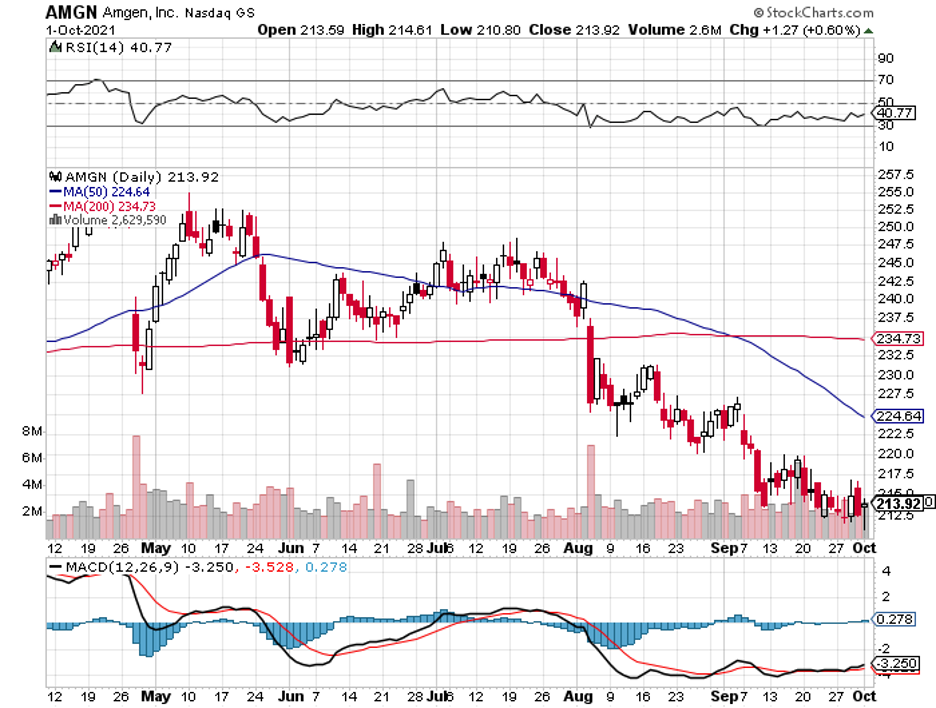
Mad Hedge Biotech & Healthcare Letter
September 7, 2021
Fiat Lux
FEATURED TRADE:
(A LONG-TERM STOCK FOR PATIENT INVESTORS)
(REGN), (RHHBY), (BAYN), (SNY), (MRK), (BMY), (NTLA)

While August ushered in the end of the “dog days of summer,” with temperatures generally at their highest throughout the US, some stocks might be just starting to get warmed up this September.
This is particularly true in the biotechnology industry.
Considering that the broad market indices are reaching historic highs, the biotechnology sector, caused by its relatively low valuation, is deemed one of the appealing targets for investors who truly understand the essence of the industry and can manage the potential risks associated with it.
While not all biotechnology companies are attractive opportunities, some are great long-term investments.
One of them is Regeneron (REGN).
In fact, Regeneron is the manufacturer of a treatment projected to become the top-selling drug globally by 2030.
Annual sales of the moneymaking drug, autoimmune diseases’ medication Dupixent, could hit $21 billion by the start of the next decade—an almost fourfold jump from its current sales estimate of $5.6 billion per annum.
The projection came following Regeneron’s announcement that Dupixent can also be used to treat atopic dermatitis among children aged 6 months to 5 years old.
This makes Dupixent the first-ever biologic treatment to release positive results for that population.
Evidently, the breadth of Dupixent’s indications, complemented by the long-established safety profile of the drug, contribute to its long-term success—an achievement that’s expected to multiply and be carried over to the next decade.
While the next decade is clearly exciting for Regeneron, the company is actually performing well these days.
So far, Regeneron shares are up by roughly 40% year to date—a record-breaking rise not only for the company but also in the biotech sector.
Regeneron’s revenue skyrocketed by 163% year-over-year in the second quarter, pushing its earnings per share to leap 260% higher.
Apart from Dupixent, another catalyst for Regeneron’s impressive gains is its COVID-19 cocktail: REGEN-COV.
This treatment, albeit controversial, is anticipated to make Regeneron and its partner, Roche (RHHBY), a lot of money in the following months, especially with the delta variant wreaking havoc in the world.
Moreover, sales for all six of Regeneron’s highest-selling products, such as its eye disease drug Eylea, which it developed with Bayer (BAYN), immunology drug Kevzara, which is a product of its collaboration with Sanofi (SNY), lung cancer treatment Libtayo, and cholesterol drug Praluent, have been consistently growing by double-digit percentages.
Apart from these current treatments displaying solid sales momentum, the company also has a loaded pipeline that can easily boost Regeneron’s revenue streams in the future.
In terms of the new products under development, Regeneron has partnered with Intellia Therapeutics (NTLA), one of the leaders in the CRISPR-Cas9 gene-editing sector, to come up with next-generation treatments.
Aside from developing new products, Regeneron is expanding the indications of its top-selling drugs. Just like its efforts with Dupixent, the company is also working on expanding Libtayo’s indications.
So far, Regeneron has been working to turn Libtayo into a go-to treatment for skin cancer.
This effort could open up new avenues for Regeneron, as at least 9,000 cases of skin cancer are recorded in the US annually.
Of these, approximately 3,200 fall under the category that the company is targeting for Libtayo’s expansion.
This is a strategic move if Regeneron has any hope to dethrone the most dominant players in this competitive immunology market: Merck’s (MRK) Keytruda and Bristol-Myers Squibb’s (BMY) Opdivo.
Looking at the average net price of Libtayo, which is at $130,000 per year, the expected sales for this drug could grow to $400 million by 2026 in the US alone and roughly $700 million worldwide—and these are only for the approved indications of the drug.
In addition to its current applications, Regeneron is also working to gain approval for Libtayo to be used for cervical cancer.
Overall, Regeneron is an excellent investment for patient buy-and-hold investors. Its current portfolio of products is performing well, while its pipeline programs and partnerships offer promising growth potential.
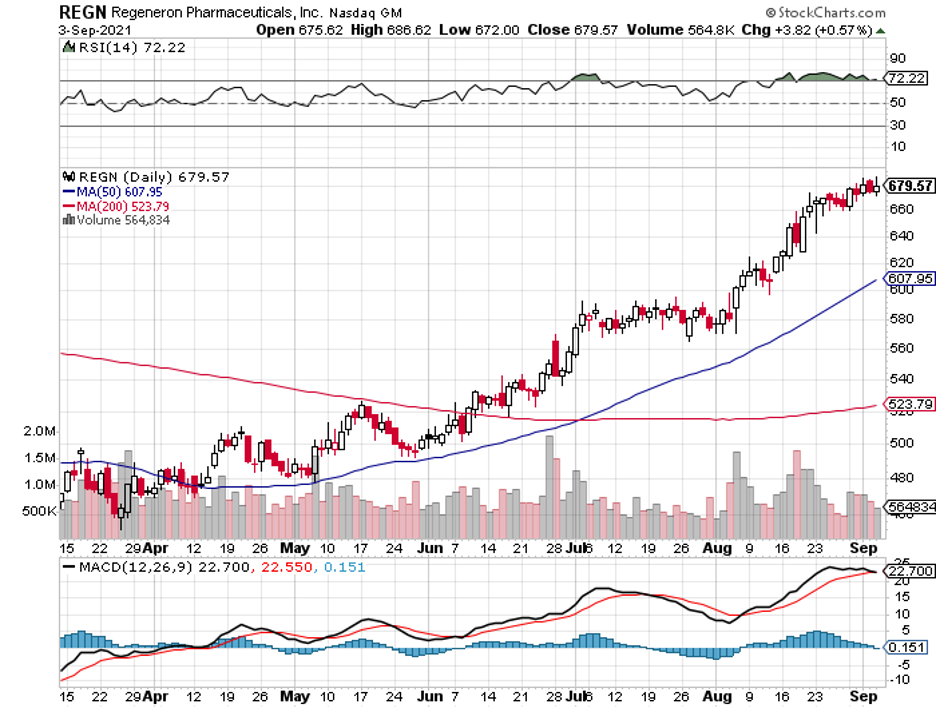
Mad Hedge Biotech & Healthcare Letter
August 31, 2021
Fiat Lux
FEATURED TRADE:
(A CANCER PIONEER FOR THE BOOKS)
(SEGN), (MRK), (BMY), (PFE), (GILD), (RHHBY), (TAK), (GMAB)
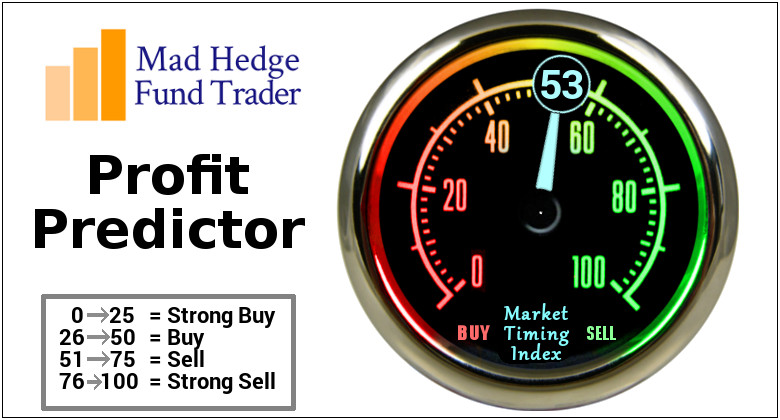
When choosing a biotechnology company to invest in, a good sign to look out for is when management continuously looks for ways to expand its technology.
This means you’re looking at a stock that’s likely to appreciate multiple folds.
Seagen (SEGN) does this in spades.
Since it was founded in 1997, Seagen (SEGN) has reached almost $30.67 billion in market capitalization.
Reviewing its growth story, I think its powerful growth strategy is one of the key elements that help the company with its advancements.
That is, Seagen is aggressively developing and expanding its different labels for the approved drugs in its portfolio while also actively discovering innovative and new treatments and molecules.
Simply put, Seagen’s growth and expansion can be likened to a tree that keeps forming new additional branches.
Over the years, the company has experienced a remarkable transformation from a single-product firm to a diversified and ever-expanding player, particularly in the oncology medication market—a strategy that paid off.
After all, the market for cancer drugs isn’t the type to stand still.
This sector is renowned for its fast-paced demands and rapid growth. If you look at how much has been done, remember that several types of cancer that seemed incurable a mere 10 years ago are now no longer considered death sentences thanks to the innovative therapies discovered.
If roughly 15 years ago, the standard cancer treatment only involved chemotherapy and surgery, the recent years have granted us access to newer technologies like targeted therapy and immunotherapy.
Lately, CAR-T therapy has been hailed as the most effective means of treating blood cancer. Meanwhile, the likes of Merck’s (MRK) Keytruda and Bristol-Myers Squibb (BMY) Opdivo have made chemotherapy and surgery more effective as well.
So, it wouldn’t be a surprise anymore if the technology in the oncology sector advances further in the years to come.
Another relatively fresh innovation is the antibody-drug conjugate (ADC) technology.
This takes and combines all the positive effects of chemotherapy and targeted therapy while simultaneously eliminating the adverse effects of chemotherapy on the patient’s body.
Unlike chemotherapy, ADCs specifically target and eliminate tumor cells and works to spare the healthy ones. Once the tumor cells are detected, a toxic drug is released to kill them.
Basically, it works like a “smart bomb” in that it annihilates only the enemies and protects the allies.
The first drug to be approved based on ADCs is Mylotarg from Pfizer (PFE), which was 20 years ago.
However, it was only in recent years that this technology finally gained traction and attracted commercial success.
So far, roughly 56 pharmaceutical companies are working on developing ADCs.
Aside from Pfizer, another pioneer in ADCs is Seagen. Unlike Pfizer, this company has chosen to continue focusing on the development of the treatment.
Other companies working on ADC technology include Immunomedics, which Gilead Sciences (GILD) acquired, and Roche (RHHBY).
However, Seagen’s work looks to be the most promising in this segment.
Its first ADC drug is Adcetris, which was approved in 2011 for Hodgkin’s lymphoma and made in cooperation with Takeda Pharmaceutical (TAK).
Its indication was later expanded to cover another white blood cell disease, Peripheral T-cell lymphoma (PTCL).
Seagen already holds roughly 45% of the market share in the Hodgkin’s lymphoma segment alone, and this is expected to rise to 50% by 2026.
In terms of projected sales in the US, Adceris is estimated to generate about $1.7 billion by 2026.
On top of that, Seagen also rakes in royalties from Adceris sales outside the US thanks to its Takeda partnership.
Riding the momentum of Adceris, Seagen expanded its ADC pipeline and later gained approval for Padcev in 2019.
This drug received the go signal to treat a fairly common disease in the oncology space: metastatic bladder cancer.
In the US, the average number of new cases of metastatic bladder cancer is 83,000. Given its market size and potential to become part of a combination therapy with the ever-popular Keytruda, Padcev is expected to generate at least $2.6 billion in sales by 2026.
Gaining more confidence in its expertise in the oncology sector, Seagen continued its expansion and gained regulatory approval for breast cancer treatment Tukysa.
Tukysa is expected to bring roughly $1 billion in annual sales in the US and European markets. This figure is projected to rise when it eventually also gains approval for colorectal cancer.
Another notable drug in Seagen’s pipeline is Tisotumab Vedotin (TV), which is a collaboration with Genmab (GMAB). TV is a cervical cancer treatment and is expected to gain approval by the end of 2021.
Shifting gears, let’s take a look at the upcoming growth of Seagen. Initially, its 2021 guidance put its annual sales at $1.28 billion for all the products.
However, Seagen has already exceeded expectations, with Adceris reporting $700 million in sales for a single quarter this year. Actually, both Adceris and Padcev are well on their way into becoming blockbusters in a year or two, thanks to their continuously expanding applications.
Overall, Seagen is an excellent long-term investment.
Aside from its work with giant biopharmaceutical companies like Merck and BMY, its current portfolio of treatments and pipeline programs present a myriad of opportunities for Seagen.
Moreover, its ability to develop powerful treatments and leverage the science of ADCs make Seagen one of the most promising oncology stocks in the market today.
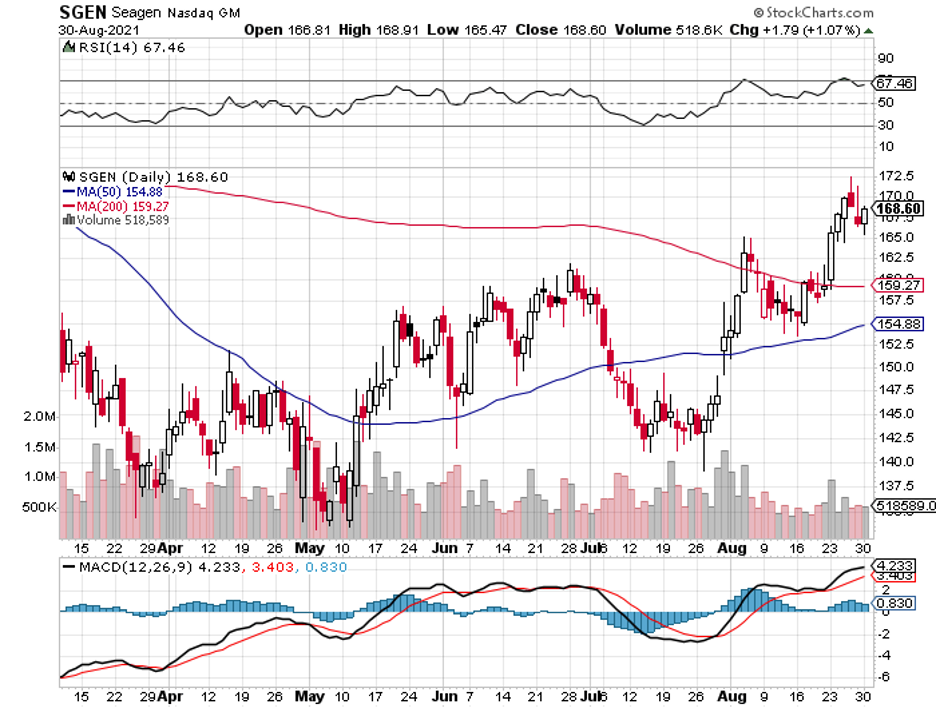
Legal Disclaimer
There is a very high degree of risk involved in trading. Past results are not indicative of future returns. MadHedgeFundTrader.com and all individuals affiliated with this site assume no responsibilities for your trading and investment results. The indicators, strategies, columns, articles and all other features are for educational purposes only and should not be construed as investment advice. Information for futures trading observations are obtained from sources believed to be reliable, but we do not warrant its completeness or accuracy, or warrant any results from the use of the information. Your use of the trading observations is entirely at your own risk and it is your sole responsibility to evaluate the accuracy, completeness and usefulness of the information. You must assess the risk of any trade with your broker and make your own independent decisions regarding any securities mentioned herein. Affiliates of MadHedgeFundTrader.com may have a position or effect transactions in the securities described herein (or options thereon) and/or otherwise employ trading strategies that may be consistent or inconsistent with the provided strategies.
This site uses cookies. By continuing to browse the site, you are agreeing to our use of cookies.
OKLearn moreWe may request cookies to be set on your device. We use cookies to let us know when you visit our websites, how you interact with us, to enrich your user experience, and to customize your relationship with our website.
Click on the different category headings to find out more. You can also change some of your preferences. Note that blocking some types of cookies may impact your experience on our websites and the services we are able to offer.
These cookies are strictly necessary to provide you with services available through our website and to use some of its features.
Because these cookies are strictly necessary to deliver the website, refuseing them will have impact how our site functions. You always can block or delete cookies by changing your browser settings and force blocking all cookies on this website. But this will always prompt you to accept/refuse cookies when revisiting our site.
We fully respect if you want to refuse cookies but to avoid asking you again and again kindly allow us to store a cookie for that. You are free to opt out any time or opt in for other cookies to get a better experience. If you refuse cookies we will remove all set cookies in our domain.
We provide you with a list of stored cookies on your computer in our domain so you can check what we stored. Due to security reasons we are not able to show or modify cookies from other domains. You can check these in your browser security settings.
These cookies collect information that is used either in aggregate form to help us understand how our website is being used or how effective our marketing campaigns are, or to help us customize our website and application for you in order to enhance your experience.
If you do not want that we track your visist to our site you can disable tracking in your browser here:
We also use different external services like Google Webfonts, Google Maps, and external Video providers. Since these providers may collect personal data like your IP address we allow you to block them here. Please be aware that this might heavily reduce the functionality and appearance of our site. Changes will take effect once you reload the page.
Google Webfont Settings:
Google Map Settings:
Vimeo and Youtube video embeds:
